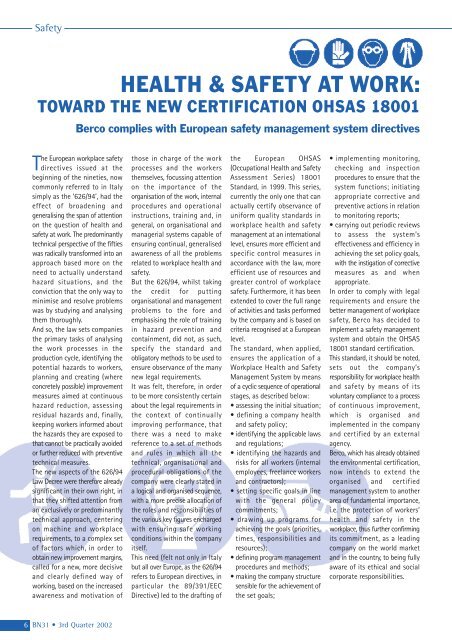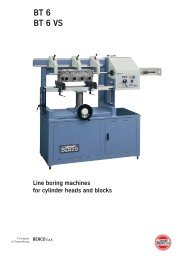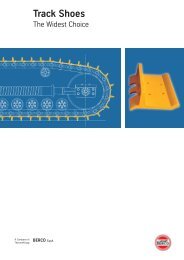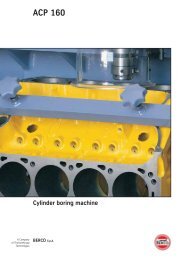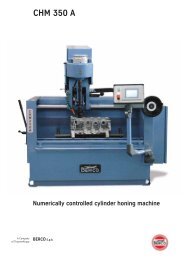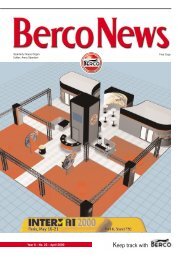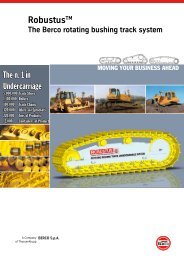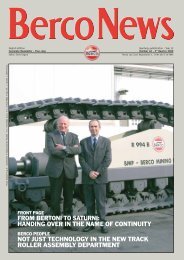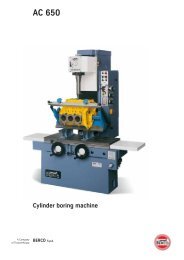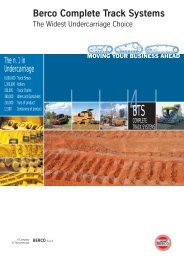New water treatment plant opened BercoSul takes its ... - Berco S.p.A
New water treatment plant opened BercoSul takes its ... - Berco S.p.A
New water treatment plant opened BercoSul takes its ... - Berco S.p.A
You also want an ePaper? Increase the reach of your titles
YUMPU automatically turns print PDFs into web optimized ePapers that Google loves.
6<br />
Safety<br />
HEALTH & SAFETY AT WORK:<br />
TOWARD THE NEW CERTIFICATION OHSAS 18001<br />
The European workplace safety<br />
directives issued at the<br />
beginning of the nineties, now<br />
commonly referred to in Italy<br />
simply as the ‘626/94’, had the<br />
effect of broadening and<br />
generalising the span of attention<br />
on the question of health and<br />
safety at work. The predominantly<br />
technical perspective of the fifties<br />
was radically transformed into an<br />
approach based more on the<br />
need to actually understand<br />
hazard situations, and the<br />
conviction that the only way to<br />
minimise and resolve problems<br />
was by studying and analysing<br />
them thoroughly.<br />
And so, the law sets companies<br />
the primary tasks of analysing<br />
the work processes in the<br />
production cycle, identifying the<br />
potential hazards to workers,<br />
planning and creating (where<br />
concretely possible) improvement<br />
measures aimed at continuous<br />
hazard reduction, assessing<br />
residual hazards and, finally,<br />
keeping workers informed about<br />
the hazards they are exposed to<br />
that cannot be practically avoided<br />
or further reduced with preventive<br />
technical measures.<br />
The new aspects of the 626/94<br />
Law Decree were therefore already<br />
significant in their own right, in<br />
that they shifted attention from<br />
an exclusively or predominantly<br />
technical approach, centering<br />
on machine and workplace<br />
requirements, to a complex set<br />
of factors which, in order to<br />
obtain new improvement margins,<br />
called for a new, more decisive<br />
and clearly defined way of<br />
working, based on the increased<br />
awareness and motivation of<br />
BN31 • 3rd Quarter 2002<br />
<strong>Berco</strong> complies with European safety management system directives<br />
those in charge of the work<br />
processes and the workers<br />
themselves, focussing attention<br />
on the importance of the<br />
organisation of the work, internal<br />
procedures and operational<br />
instructions, training and, in<br />
general, on organisational and<br />
managerial systems capable of<br />
ensuring continual, generalised<br />
awareness of all the problems<br />
related to workplace health and<br />
safety.<br />
But the 626/94, whilst taking<br />
the credit for putting<br />
organisational and management<br />
problems to the fore and<br />
emphasising the role of training<br />
in hazard prevention and<br />
containment, did not, as such,<br />
specify the standard and<br />
obligatory methods to be used to<br />
ensure observance of the many<br />
new legal requirements.<br />
It was felt, therefore, in order<br />
to be more consistently certain<br />
about the legal requirements in<br />
the context of continually<br />
improving performance, that<br />
there was a need to make<br />
reference to a set of methods<br />
and rules in which all the<br />
technical, organisational and<br />
procedural obligations of the<br />
company were clearly stated in<br />
a logical and organised sequence,<br />
with a more precise allocation of<br />
the roles and responsibilities of<br />
the various key figures encharged<br />
with ensuring safe working<br />
conditions within the company<br />
<strong>its</strong>elf.<br />
This need (felt not only in Italy<br />
but all over Europe, as the 626/94<br />
refers to European directives, in<br />
particular the 89/391/EEC<br />
Directive) led to the drafting of<br />
the European OHSAS<br />
(Occupational Health and Safety<br />
Assessment Series) 18001<br />
Standard, in 1999. This series,<br />
currently the only one that can<br />
actually certify observance of<br />
uniform quality standards in<br />
workplace health and safety<br />
management at an international<br />
level, ensures more efficient and<br />
specific control measures in<br />
accordance with the law, more<br />
efficient use of resources and<br />
greater control of workplace<br />
safety. Furthermore, it has been<br />
extended to cover the full range<br />
of activities and tasks performed<br />
by the company and is based on<br />
criteria recognised at a European<br />
level.<br />
The standard, when applied,<br />
ensures the application of a<br />
Workplace Health and Safety<br />
Management System by means<br />
of a cyclic sequence of operational<br />
stages, as described below:<br />
• assessing the initial situation;<br />
• defining a company health<br />
and safety policy;<br />
• identifying the applicable laws<br />
and regulations;<br />
• identifying the hazards and<br />
risks for all workers (internal<br />
employees, freelance workers<br />
and contractors);<br />
• setting specific goals in line<br />
with the general policy<br />
commitments;<br />
• drawing up programs for<br />
achieving the goals (priorities,<br />
times, responsibilities and<br />
resources);<br />
• defining program management<br />
procedures and methods;<br />
• making the company structure<br />
sensible for the achievement of<br />
the set goals;<br />
• implementing monitoring,<br />
checking and inspection<br />
procedures to ensure that the<br />
system functions; initiating<br />
appropriate corrective and<br />
preventive actions in relation<br />
to monitoring reports;<br />
• carrying out periodic reviews<br />
to assess the system’s<br />
effectiveness and efficiency in<br />
achieving the set policy goals,<br />
with the instigation of corrective<br />
measures as and when<br />
appropriate.<br />
In order to comply with legal<br />
requirements and ensure the<br />
better management of workplace<br />
safety, <strong>Berco</strong> has decided to<br />
implement a safety management<br />
system and obtain the OHSAS<br />
18001 standard certification.<br />
This standard, it should be noted,<br />
sets out the company’s<br />
responsibility for workplace health<br />
and safety by means of <strong>its</strong><br />
voluntary compliance to a process<br />
of continuous improvement,<br />
which is organised and<br />
implemented in the company<br />
and certified by an external<br />
agency.<br />
<strong>Berco</strong>, which has already obtained<br />
the environmental certification,<br />
now intends to extend the<br />
organised and certified<br />
management system to another<br />
area of fundamental importance,<br />
i.e. the protection of workers’<br />
health and safety in the<br />
workplace, thus further confirming<br />
<strong>its</strong> commitment, as a leading<br />
company on the world market<br />
and in the country, to being fully<br />
aware of <strong>its</strong> ethical and social<br />
corporate responsibilities.


